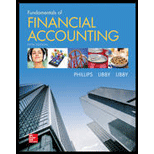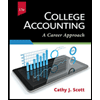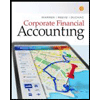
Fundamentals of Financial Accounting
5th Edition
ISBN: 9780078025914
Author: Fred Phillips Associate Professor, Robert Libby, Patricia Libby
Publisher: McGraw-Hill Education
expand_more
expand_more
format_list_bulleted
Concept explainers
Question
Chapter 5, Problem 5.10E
(1)
To determine
To journalize: The entry for the transaction occurred on January 1
(2)
To determine
To journalize: The entries for the transactions occurred from January 2 through 15
(3)
To determine
To journalize: The entry for the transaction occurred on January 17
Expert Solution & Answer
Want to see the full answer?
Check out a sample textbook solution
Students have asked these similar questions
Can you explain this general accounting question using accurate calculation methods?
Can you solve this general accounting problem using accurate calculation methods?
subject=general accounting
Chapter 5 Solutions
Fundamentals of Financial Accounting
Ch. 5 - Prob. 1QCh. 5 - Prob. 2QCh. 5 - Prob. 3QCh. 5 - Prob. 4QCh. 5 - Prob. 5QCh. 5 - What aspect(s) of the Sarbanes-Oxley Act might...Ch. 5 - Prob. 7QCh. 5 - What are the five components of an internal...Ch. 5 - Prob. 9QCh. 5 - Why is it a good idea to assign each task to only...
Ch. 5 - Prob. 11QCh. 5 - Prob. 12QCh. 5 - Prob. 13QCh. 5 - Prob. 14QCh. 5 - Prob. 15QCh. 5 - Prob. 16QCh. 5 - What is the primary internal control goal for cash...Ch. 5 - Prob. 18QCh. 5 - Prob. 19QCh. 5 - Prob. 20QCh. 5 - Prob. 21QCh. 5 - Prob. 22QCh. 5 - Prob. 23QCh. 5 - Prob. 24QCh. 5 - Prob. 1MCCh. 5 - Prob. 2MCCh. 5 - Prob. 3MCCh. 5 - Prob. 4MCCh. 5 - Which of the following internal control principles...Ch. 5 - Prob. 6MCCh. 5 - Prob. 7MCCh. 5 - Prob. 8MCCh. 5 - Prob. 9MCCh. 5 - Prob. 10MCCh. 5 - Prob. 5.1MECh. 5 - Prob. 5.2MECh. 5 - Prob. 5.3MECh. 5 - Prob. 5.4MECh. 5 - Prob. 5.5MECh. 5 - Prob. 5.6MECh. 5 - Prob. 5.7MECh. 5 - Prob. 5.8MECh. 5 - Prob. 5.9MECh. 5 - Prob. 5.10MECh. 5 - Prob. 5.11MECh. 5 - Prob. 5.12MECh. 5 - Prob. 5.13MECh. 5 - Prob. 5.14MECh. 5 - Prob. 5.15MECh. 5 - Prob. 5.16MECh. 5 - Identifying Internal Control Principle and...Ch. 5 - Prob. 5.2ECh. 5 - Prob. 5.3ECh. 5 - Prob. 5.4ECh. 5 - Prob. 5.5ECh. 5 - Prob. 5.6ECh. 5 - Prob. 5.7ECh. 5 - Prob. 5.8ECh. 5 - Prob. 5.9ECh. 5 - Prob. 5.10ECh. 5 - Prob. 5.1CPCh. 5 - Prob. 5.2CPCh. 5 - Prob. 5.3CPCh. 5 - Prob. 5.4CPCh. 5 - Prob. 5.1PACh. 5 - Prob. 5.2PACh. 5 - Prob. 5.3PACh. 5 - Prob. 5.4PACh. 5 - Prob. 5.1PBCh. 5 - Prob. 5.2PBCh. 5 - Prob. 5.3PBCh. 5 - Prob. 5.4PBCh. 5 - Recording Transactions and Adjustments,...Ch. 5 - Prob. 5.1SDCCh. 5 - Prob. 5.2SDCCh. 5 - Ethical Decision Making: A Real-Life Example When...Ch. 5 - Ethical Decision Making: A Mini-Case You are an...Ch. 5 - Accounting for Cash Receipts, Purchases, and Cash...
Knowledge Booster
Learn more about
Need a deep-dive on the concept behind this application? Look no further. Learn more about this topic, accounting and related others by exploring similar questions and additional content below.Similar questions
- I am looking for help with this general accounting question using proper accounting standards.arrow_forwardPlease provide the accurate answer to this general accounting problem using valid techniques.arrow_forwardCan you help me solve this general accounting question using the correct accounting procedures?arrow_forward
- Please provide the correct answer to this general accounting problem using accurate calculations.arrow_forwardI need help with this general accounting question using standard accounting techniques.arrow_forwardI need guidance with this general accounting problem using the right accounting principles.arrow_forward
arrow_back_ios
SEE MORE QUESTIONS
arrow_forward_ios
Recommended textbooks for you
- Principles of Accounting Volume 1AccountingISBN:9781947172685Author:OpenStaxPublisher:OpenStax College
 College Accounting (Book Only): A Career ApproachAccountingISBN:9781337280570Author:Scott, Cathy J.Publisher:South-Western College PubCentury 21 Accounting Multicolumn JournalAccountingISBN:9781337679503Author:GilbertsonPublisher:Cengage
College Accounting (Book Only): A Career ApproachAccountingISBN:9781337280570Author:Scott, Cathy J.Publisher:South-Western College PubCentury 21 Accounting Multicolumn JournalAccountingISBN:9781337679503Author:GilbertsonPublisher:Cengage  Financial Accounting: The Impact on Decision Make...AccountingISBN:9781305654174Author:Gary A. Porter, Curtis L. NortonPublisher:Cengage Learning
Financial Accounting: The Impact on Decision Make...AccountingISBN:9781305654174Author:Gary A. Porter, Curtis L. NortonPublisher:Cengage Learning Corporate Financial AccountingAccountingISBN:9781305653535Author:Carl Warren, James M. Reeve, Jonathan DuchacPublisher:Cengage Learning
Corporate Financial AccountingAccountingISBN:9781305653535Author:Carl Warren, James M. Reeve, Jonathan DuchacPublisher:Cengage Learning

Principles of Accounting Volume 1
Accounting
ISBN:9781947172685
Author:OpenStax
Publisher:OpenStax College

College Accounting (Book Only): A Career Approach
Accounting
ISBN:9781337280570
Author:Scott, Cathy J.
Publisher:South-Western College Pub

Century 21 Accounting Multicolumn Journal
Accounting
ISBN:9781337679503
Author:Gilbertson
Publisher:Cengage


Financial Accounting: The Impact on Decision Make...
Accounting
ISBN:9781305654174
Author:Gary A. Porter, Curtis L. Norton
Publisher:Cengage Learning

Corporate Financial Accounting
Accounting
ISBN:9781305653535
Author:Carl Warren, James M. Reeve, Jonathan Duchac
Publisher:Cengage Learning